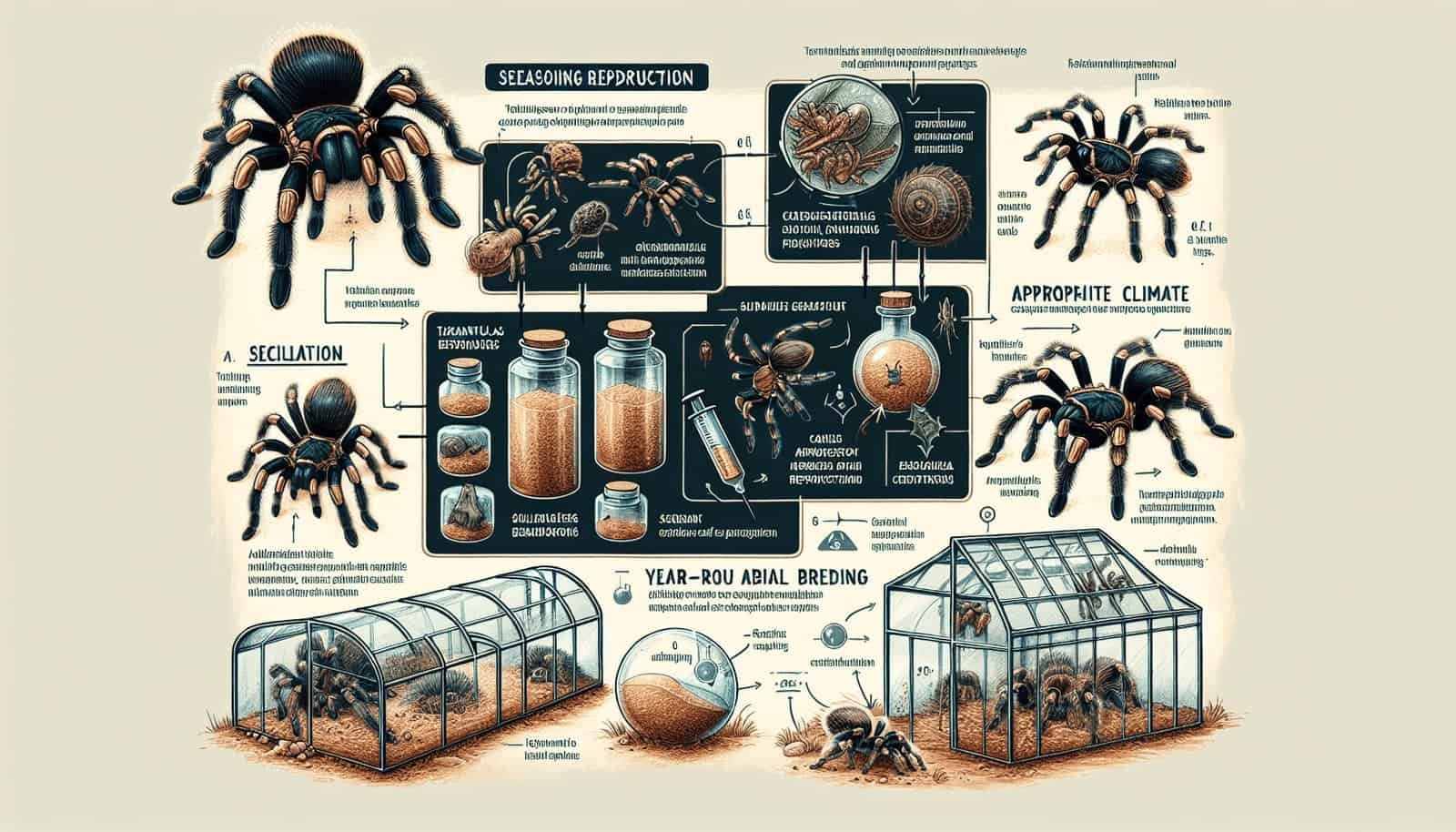Have you ever wondered if tarantulas can be bred throughout the year or if there are specific breeding seasons for these intriguing arachnids? Well, the answer may surprise you! In this article, we will explore the fascinating world of tarantula breeding and uncover whether these creatures follow a strict schedule when it comes to reproduction. Whether you are a tarantula enthusiast or simply curious about the mysterious lives of these eight-legged creatures, you won’t want to miss out on this insightful read. So, let’s embark on a journey into the realm of tarantula breeding and discover the secrets behind their reproductive cycles.

Introduction
Breeding tarantulas can be a fascinating and rewarding experience for enthusiasts, but it’s important to understand the complexities of their breeding seasons. Tarantulas, like many other animals, have specific times of the year when they are more likely to engage in mating behaviors and successfully reproduce. By understanding the factors that affect tarantula breeding, as well as the variations in breeding seasons among different species, we can better prepare for successful captive breeding and contribute to conservation efforts.
Factors Affecting Tarantula Breeding
Several factors play a crucial role in tarantula breeding, including temperature, humidity, light, and day length. These environmental factors can influence the physiological and behavioral changes necessary for successful mating and reproduction.
Temperature
Tarantulas are ectothermic, meaning their body temperature is regulated by their environment. Different species have different temperature preferences for breeding. For example, tropical species often require consistently warm temperatures, while temperate species may have specific temperature ranges that trigger breeding behaviors. It’s essential to create the right temperature conditions to encourage tarantulas to mate and reproduce successfully.
Humidity
Humidity levels can significantly impact tarantula breeding. Many tarantulas are native to humid environments, and maintaining appropriate humidity levels in captive breeding setups can replicate their natural conditions. Adequate humidity ensures proper mating behaviors, egg development, and overall reproductive success. Tarantulas from desert environments, however, may require lower humidity levels during breeding.
Light
Light plays an essential role in regulating tarantula behavior and breeding activities. In the wild, changes in daylight hours and intensity are seasonal cues that trigger mating behaviors. Additionally, light exposure can also affect the development and growth of eggs. By replicating natural light patterns in captivity, tarantula breeders can increase the chances of successful reproduction.
Day Length
The length of daylight also affects tarantula breeding. Different species have varying day length requirements to initiate courtship and mating. Some tarantulas may require shorter days, signaling the onset of breeding behaviors, while others may need longer days to stimulate successful reproduction. By mimicking the natural day length cycles, breeders can help tarantulas meet their specific breeding needs.

Species Variation in Breeding Seasons
Tarantulas come from a wide range of habitats, and their breeding seasons can vary greatly depending on their natural environment. Understanding the different breeding seasons among species is crucial for successful captive breeding.
Tropical species
Tropical tarantulas generally do not have specified breeding seasons and can breed year-round, given the right environmental conditions. These species typically require consistently warm temperatures and high humidity levels to trigger mating and reproduction.
Temperate species
Temperate tarantulas, on the other hand, have more defined breeding seasons, often corresponding to the changing seasons in their native habitats. These species are adapted to specific climates, and their breeding behaviors are often triggered by seasonal temperature and daylight changes.
Desert species
Tarantulas found in desert environments often have unique breeding adaptations due to limited resources. While some desert species may have specific breeding seasons, others have evolved to be opportunistic breeders, taking advantage of favorable conditions whenever they arise. These tarantulas may not have a distinct breeding season but instead reproduce in response to rainfall events.
Influence of Seasonal Changes on Tarantula Reproduction
Seasonal changes play a critical role in tarantula reproduction and can have various impacts on their behaviors and overall success in breeding.
Triggering mating behaviors
Seasonal changes, particularly temperature and day length variations, can trigger the onset of tarantula mating behaviors. As the breeding season approaches, tarantulas may become more active, engage in courtship rituals, and exhibit increased aggression towards potential mates. These behaviors are often associated with hormonal changes triggered by environmental cues.
Favorable conditions for egg development
Seasonal changes also provide the optimal conditions for successful egg development in tarantulas. The availability of prey, temperature fluctuations, and changes in humidity levels all contribute to the development and viability of tarantula eggs. These fluctuating environmental factors can influence the duration of egg incubation and overall breeding success.
Availability of prey during different seasons
In the wild, tarantulas rely on the availability of prey to sustain themselves during and after the breeding season. Seasonal variations in the abundance of insects and other food sources can influence tarantula breeding by providing the necessary energy and nutrition for mating, egg production, and parental care. Understanding these prey availability patterns is essential when breeding tarantulas in captivity.

Breeding Tarantulas in Captivity
Breeding tarantulas in captivity requires careful planning and the creation of appropriate environmental conditions to mimic their natural habitats. Captive breeding not only ensures the sustainability of tarantula populations but also allows enthusiasts to observe and learn about their fascinating reproductive behaviors.
Understanding captive breeding
Captive breeding involves replicating the necessary environmental conditions for successful tarantula reproduction within confined spaces. It requires knowledge of the specific requirements of the species being bred, including temperature, humidity, light, and prey availability. Captive breeding programs aim to maintain genetic diversity, avoid reliance on wild-caught specimens, and contribute to conservation efforts.
Recreating ideal conditions
To successfully breed tarantulas in captivity, it is crucial to recreate their ideal environmental conditions as closely as possible. This includes maintaining appropriate temperature ranges, humidity levels, and light cycles based on the species’ natural habitats. Providing suitable hiding spots, substrate, and other habitat features also contribute to the overall well-being and breeding success of tarantulas.
Manipulating environmental factors
In captivity, breeders have the flexibility to manipulate certain environmental factors to encourage breeding behaviors. By carefully adjusting temperature, humidity, and light conditions, breeders can create the optimal conditions for tarantulas to engage in courtship rituals, mate, and lay eggs. These manipulations should align with the natural breeding cycles of the specific species being bred.
Providing appropriate diet
A well-balanced diet is crucial for successful tarantula breeding in captivity. Proper nutrition ensures that both males and females are in optimal reproductive condition. Providing a varied diet of live insects, such as crickets and mealworms, supplemented with essential vitamins and minerals, can increase the chances of successful mating and the development of healthy offspring.
Challenges of Breeding Tarantulas
Breeding tarantulas can be challenging due to several factors that need to be carefully managed and overcome.
Identifying the correct species
Accurately identifying tarantula species is essential when it comes to successful breeding. Different species have specific breeding requirements, and attempting to breed incompatible species can lead to aggression, injury, or cannibalism. It is crucial to have a thorough understanding of the species’ natural history and breeding behaviors before attempting to breed them in captivity.
Matching compatible mates
Finding compatible mates for tarantulas can be a challenge, especially if the species is rare or not commonly bred in captivity. Ensuring that the male and female tarantulas are of similar size, age, and genetic background is crucial for successful mating. Breeders may need to network with other enthusiasts, participate in breeding programs, or seek guidance from experts to find suitable mates for their tarantulas.
Overcoming aggression and cannibalism
Tarantulas are known for their cannibalistic tendencies, especially during the breeding process. Females may attack and consume males before, during, or after mating. Breeders need to carefully monitor the behaviors of the tarantulas during breeding attempts to prevent injury or death. Separating the male from the female immediately after mating is often necessary to ensure his safety.

Breeding Strategies for Tarantula Enthusiasts
Successful tarantula breeding requires careful planning and execution of specific strategies to increase the chances of breeding success.
Timing the breeding attempt
Understanding the breeding season and specific timing requirements of the tarantula species being bred is crucial. Researching the natural history and reproductive behaviors of the species can guide breeders in selecting the most appropriate time to initiate breeding attempts.
Introducing male and female tarantulas
When introducing male and female tarantulas for breeding, it is vital to monitor their behaviors closely. Tarantulas engage in courtship rituals before mating, which can involve elaborate displays and maneuvers. Observing these behaviors can help determine if the pair is compatible and ready to mate.
Observing courtship rituals
Tarantula courtship rituals can be intricate and exciting to observe. Males may perform intricate dancing or tapping behaviors to attract the females’ attention. Different species have unique courtship rituals, and it is essential to be patient and observe closely to understand when successful mating is about to occur.
Removing the male after mating
To ensure the male’s safety and prevent post-mating cannibalism, it is crucial to remove him from the female’s enclosure immediately after mating. Males typically have a shorter lifespan compared to females, and prolonged exposure to the female may result in injury or death. Separate housing should be provided for the male to recover and potentially be used for future breeding attempts.
Record-Keeping and Documentation
Maintaining detailed records and documentation is essential for successful tarantula breeding and contributes to the overall understanding and knowledge sharing within the tarantula community.
Documenting environmental conditions
Recording and monitoring the environmental conditions, including temperature, humidity, light cycles, and prey availability, throughout the breeding process is crucial. These records help breeders identify patterns and optimize breeding conditions for future attempts.
Tracking breeding attempts and outcomes
Recording breeding attempts, including the specific individuals involved, behaviors observed, and outcomes (successful or unsuccessful mating, number of eggs laid, etc.), helps track breeding success rates and identify potential areas for improvement. These records also provide valuable data for research and conservation purposes.
Sharing information within the tarantula community
Sharing breeding experiences, techniques, and outcomes with other tarantula enthusiasts is essential for the advancement of knowledge within the community. Online forums, social media groups, and specialized breeding programs allow breeders to share information, seek advice, and contribute to the collective understanding of tarantula breeding.

Future Research Directions
While there is a wealth of knowledge about tarantula breeding, there are still several areas that warrant further research and exploration.
Studying breeding patterns in different tarantula species
Each tarantula species has its unique breeding behaviors and requirements. Further research is needed to understand the breeding patterns of different species more comprehensively. This research can help improve breeding success rates, refine captive breeding techniques, and contribute to the conservation of endangered tarantula species.
Investigating the impact of climate change on tarantula reproduction
Climate change can have far-reaching impacts on animal reproduction, including tarantulas. Studying how changing temperatures, altered rainfall patterns, and shifting seasons affect tarantula breeding can provide valuable insights into their adaptability and vulnerability in the face of environmental changes.
Exploring genetic diversity in captive-bred tarantulas
Captive breeding programs play a crucial role in maintaining genetic diversity and safeguarding the future of tarantulas. Research on the genetic diversity of captive-bred tarantulas can help identify potential inbreeding risks and develop strategies to preserve and enhance genetic diversity within captive populations.
Conclusion
Understanding tarantula breeding seasons and the factors that influence successful reproduction is essential for tarantula enthusiasts and breeders. By recreating the ideal environmental conditions, carefully selecting compatible mates, and following appropriate breeding strategies, enthusiasts can both enjoy the fascinating process of tarantula breeding and contribute to the conservation efforts aimed at preserving these unique creatures. Through continued research and knowledge sharing, we can further deepen our understanding of tarantula breeding and help ensure the long-term success and sustainability of these captivating arachnids.
